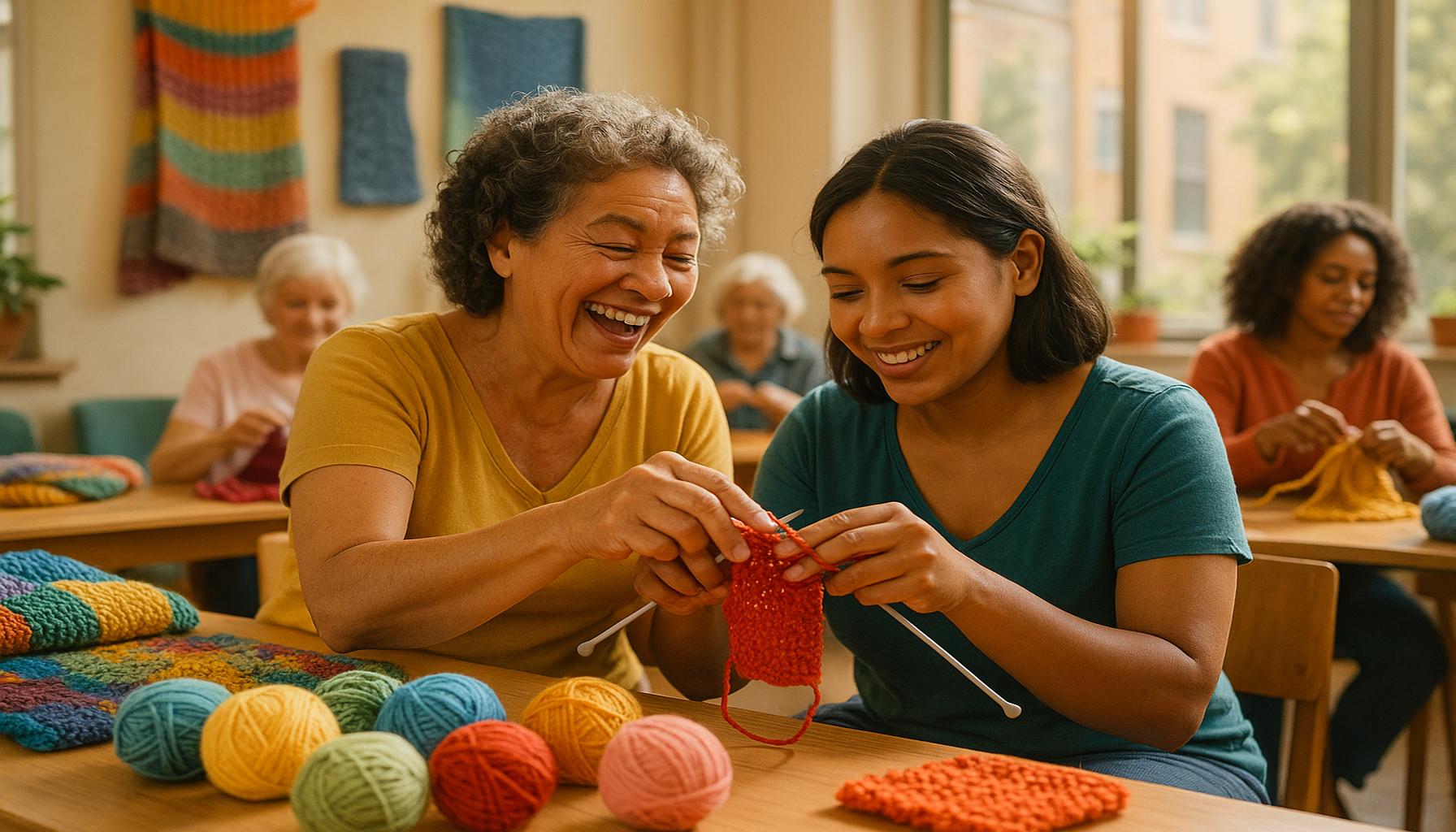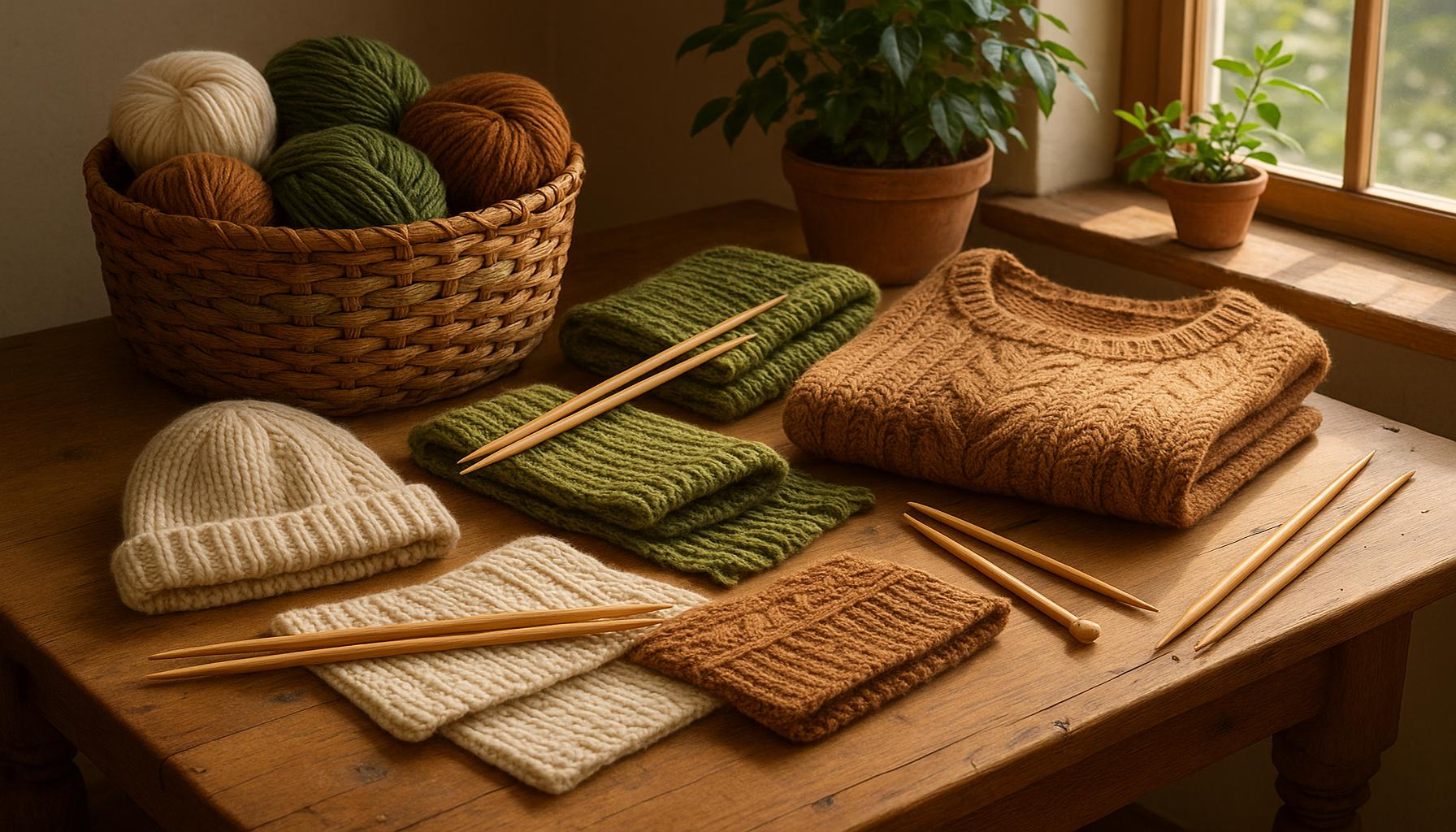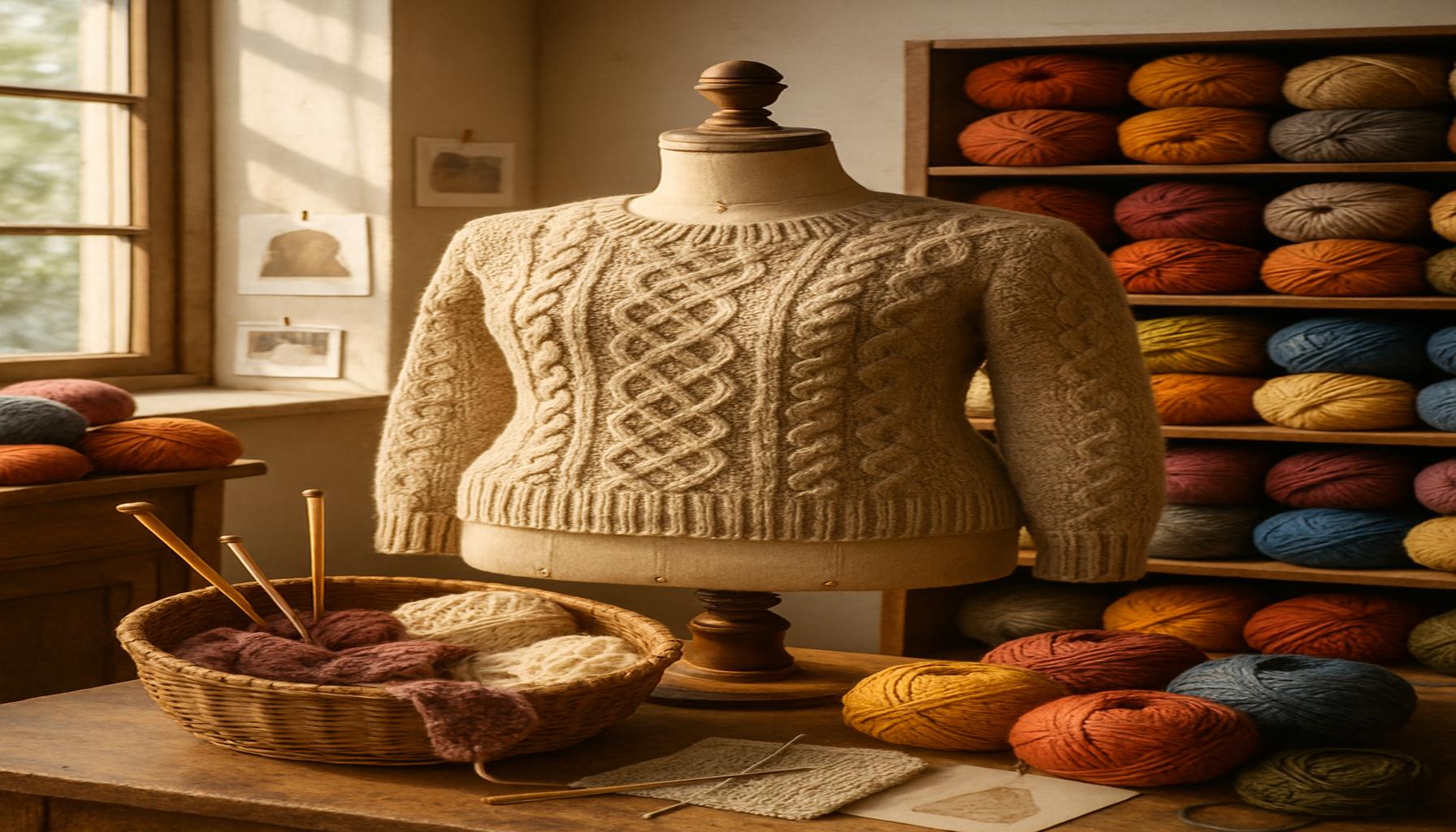Knitting as a Tool for Empowerment: Stories of Women Transforming Lives Through Art

Weaving Resilience into Fabric
In recent years, the act of knitting has emerged as a profoundly transformative force among women across the United States. This craft, traditionally perceived as a leisurely pastime, has evolved into a pivotal instrument for empowerment, enabling women to not only express their creativity but also to reclaim their lives in various meaningful ways. Through the rhythmic motions of working with yarn, countless individuals have experienced significant personal growth and forged deeper connections within their communities.
Community Building
Knitting circles have sprung up in various towns and cities, creating spaces where women gather to share not just yarn and patterns, but also support and encouragement. These communal gatherings serve as safe havens where participants can swap stories and life experiences, fostering bonds that often extend beyond the craft itself. For instance, the “Knit for Peace” initiative has inspired local groups to host sessions focused on knitting blankets and garments for those in need, such as the homeless or refugee communities. This shared purpose not only enhances skills but also instills a sense of belonging and solidarity.
Therapeutic Benefits
The act of knitting holds remarkable therapeutic benefits. Scientific studies have shown that the repetitive motions involved in this craft can help alleviate stress and anxiety. The focus required in knitting can serve as a form of mindfulness, allowing individuals to escape the hustle and bustle of daily life and enter a state of meditative calm. Women battling mental health challenges have found solace in their craft, experiencing an uplift in mood and a sense of accomplishment as they complete each project.
Economic Empowerment
Beyond personal growth, knitting has become a viable avenue for economic empowerment. Many women have transformed their hobby into successful small businesses, selling their handmade products through local markets or online platforms like Etsy. These ventures not only provide a supplementary income but also promote financial independence and entrepreneurship. For example, initiatives like “Knit for the Cure,” which combines crafting with fundraising for cancer research, allow skilled knitters to promote their work while contributing to a larger cause.
Advocacy for Causes
Knitting has also become a powerful tool for advocacy. Various groups utilize their knitting skills to raise awareness about pressing social issues, creating handmade items that symbolize movements ranging from women’s rights to environmental conservation. The iconic “Pussyhat Project,” which originated during the Women’s March in 2017, serves as a remarkable example of how a simple craft can unite thousands in a powerful statement of solidarity and progress.
As we uncover the myriad stories of women whose lives have been transformed through knitting, we see a tapestry rich with personal and community narratives. Each thread woven into their projects reinforces the belief in new beginnings and empowered futures. Through these shared experiences, knitting proves to be far more than just a craft; it becomes a profound catalyst for connection, creativity, and change, illuminating the strength found in community and resilience.
DISCOVER MORE: Click here to dive deeper
Stitching Together Stories of Transformation
As knitting transcends its traditional roots, stories of women transforming their lives through this humble craft have started to emerge. Each stitch holds a narrative woven with resilience, determination, and creativity. In communities across the United States, women are discovering how knitting serves as a powerful medium for self-expression and personal growth, offering them more than just the satisfaction of completing a project.
A Gateway to Self-Discovery
For many women, knitting is a journey of self-discovery. Engaging with yarn and needles allows them to focus on their inner thoughts and aspirations, often leading to a new understanding of their capabilities. Janelle from Portland, Oregon, shares her experience with anxiety and depression, stating that “knitting has been a lifeline for me. It calms my mind and gives me a sense of accomplishment every time I finish a piece.” Such sentiments echo across countless stories, illustrating how the simple act of creating can encourage women to navigate their mental landscapes and bolster their self-esteem.
Skill Development and Creativity
Knitting is also a platform for enhancing practical skills and nurturing creativity. Women of all ages are embracing this craft and participating in workshops that enhance their technical abilities. Some skills that knitters develop include:
- Pattern Reading: Understanding patterns expands creative horizons and boosts problem-solving abilities.
- Manual Dexterity: The physical act of knitting improves fine motor skills, which is especially beneficial for older adults.
- Color Theory: Choosing colors and textures fosters artistic expression and develops an eye for aesthetics.
- Project Management: Planning and completing projects teaches organization and time management skills.
By honing these skills, women not only enrich their own lives but also inspire those around them. Local community centers and libraries are increasingly offering knitting classes, creating avenues for women to explore their craft while forming friendships and mentorship opportunities.
The Ripple Effect of Empowerment
The ripple effect of women’s empowerment through knitting can be profound. As these women gain confidence and skills, they often feel inspired to give back to their communities. Many join initiatives aimed at supporting various causes, such as creating handmade items for cancer patients or teaching children in underprivileged neighborhoods how to knit. This act of giving back not only allows them to use their talents to uplift others but also reinforces their sense of purpose and belonging.
Knitting circles have become incubators for social change, as women unite to tackle issues they are passionate about. From using knitting as a means to promote mental health awareness to crafting items for disaster relief, these projects symbolize the determination and strength of women who are not just knitting for themselves but also for the world around them.
As we delve deeper into the stories of transformation, it becomes clear that knitting is more than just a craft: it serves as a vibrant expression of women’s empowerment, uniting them in a tapestry rich with creativity, resilience, and advocacy for change.
| Empowerment through Community | Building Skills and Confidence |
|---|---|
| Collaboration | Knitting circles provide a safe space for women to share experiences and build confidence. |
| Social Bonds | Participants often form lasting friendships, enhancing their mental well-being. |
In various communities worldwide, women have harnessed the art of knitting not just as a craft but as a powerful tool for empowerment. By participating in **knitting circles**, they engage in collaborative projects that enhance their social networks and foster a sense of belonging. These gatherings often become more than just a hobby; they evolve into support systems where women share challenges and victories, resulting in strengthened emotional resilience. Moreover, the process of teaching and learning new knitting techniques helps in sharpening skills that can translate into other areas of life, from improved concentration to increased patience. As they develop their craft, these women build a sense of ownership and achievement, ultimately leading to improved self-esteem and confidence. The art of knitting thus emerges as not just a means of creating beautiful pieces but a profound source of personal transformation and community building that inspires many to delve deeper into their creativity.
DIVE DEEPER: Click here to uncover the secrets of storytelling
Weaving Community Bonds
Knitting is not just an individual endeavor; it often serves as a bridge connecting women to supportive networks. In cities and towns across America, knitting circles have emerged as communal hubs where women gather to share their passion for the craft and build lasting friendships. These gatherings create an atmosphere of solidarity and encouragement, where participants exchange not only tips about knitting techniques but also personal stories about triumphs and challenges.
Building Networks of Support
Many knitting circles extend beyond mere hobbyist gatherings; they function as vital support networks for women navigating difficult life transitions. Initiatives like “Stitching for Healing,” based in San Francisco, provide a safe space for women grappling with grief or trauma. Sessions are designed to foster emotional support alongside knitting practice, highlighting how art can become an effective tool in healing. Participants often report feeling liberated through the connection they forge with others who understand their struggles, amplifying feelings of empowerment and resilience.
Moreover, knitting communities can play a pivotal role in bridging generational gaps. Younger women are often mentored by older generations, sharing skills while exchanging wisdom that extends far beyond knitting. This intergenerational interaction enriches both groups, nurturing a sense of legacy and tradition within the craft, while also empowering women to pass on essential life skills.
A Platform for Social Change
Knitting circles have also emerged as platforms for social activism, allowing women to channel their creativity into tangible action. The global initiative “Knitting for Peace” has inspired local groups to create items for those in need, including hats for premature infants, blankets for the homeless, or scarves for low-income families during winter months. Through these collective efforts, women not only bolster their knitting skills but also derive a profound sense of community purpose.
In 2021, a group of women knitters in Chicago organized a project called “Yarn for Justice,” aimed at raising awareness for social issues such as racial inequality and women’s rights. Through their art, these knitters created stunning visual installations that sparked dialogue and drew attention to pressing societal issues. This movement illustrates how women, armed with their knitting needles, can make statements that ripple outward into their communities.
Knitting as a Tool for Economic Empowerment
The economic impact of knitting as a form of empowerment cannot be overlooked. Many women have turned their passion for knitting into profitable cottage industries. By selling handmade products online through platforms such as Etsy or local craft fairs, women are not only generating income but also asserting their independence. For instance, Maria from Austin, Texas, turned her knitting hobby into a thriving business selling unique knitted accessories. She credits her craft with helping her regain control over her life after losing her job during the pandemic.
The rise of this home-based economy is particularly important for women who face barriers in traditional job markets. Armed with skill and creativity, they tap into the growing demand for sustainable, handmade goods, thereby finding empowerment in their craft as they contribute to local economies. Moreover, workshops that teach knitting and entrepreneurship skills empower women with the knowledge they need to succeed in this emerging market.
As the stories of these transformative journeys unfold, it becomes increasingly clear that knitting evolves beyond mere pastime; it represents a multidimensional tool of empowerment that women are leveraging in ways that pique curiosity and inspire social innovation.
DISCOVER MORE: Click here to dive into sustainable knitting
Conclusion: The Threads of Change
As we explore the profound stories of women transforming their lives through knitting, it’s evident that this art form extends far beyond the tactile satisfaction of creating fabric. Knitting serves as a powerful tool of empowerment, enabling women to forge connections, heal from trauma, and assert their independence in an ever-evolving economic landscape. The communal gathering of knitting circles not only facilitates the sharing of skills but also nurtures lasting relationships that empower women to confront their challenges together.
Through initiatives like “Stitching for Healing” and “Yarn for Justice,” participants have leveraged their passion for sewing to address social issues and advocate for change within their communities. These women, armed with traditionally domestic skills, reveal how art can drive social activism, shedding light on critical societal problems while executing acts of love and solidarity. Furthermore, the economic potential of knitting is becoming increasingly recognized; as women build businesses around their craft, they harness their creativity, earning both income and personal growth in the process.
In a world craving connection and purpose, the movement of knitting transcends mere hobby into a vital aspect of empowerment and community building. These threads beckon us to recognize the transformative power of art—an invitation to embrace our own creativity as a means of change. Ultimately, the stories of these women illuminate that the simple act of knitting can weave together a tapestry of resilience, solidarity, and inspiration—one stitch at a time.



